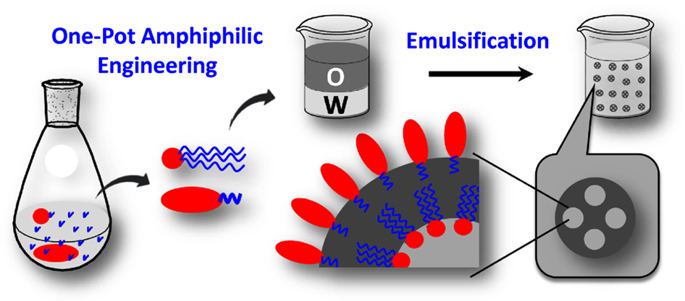Our official English website, www.x-mol.net, welcomes your
feedback! (Note: you will need to create a separate account there.)
One-pot amphiphilic engineering of bioresorbable polymers for constructing colloidal vesicles and prolonging protein delivery
Polymer Journal ( IF 2.3 ) Pub Date : 2019-09-24 , DOI: 10.1038/s41428-019-0267-3 Chiung-Yi Huang , Yu-Jhen Cheng , Hui-Min Ho , Chung-Hsiung Huang , Ming-Hsi Huang
Polymer Journal ( IF 2.3 ) Pub Date : 2019-09-24 , DOI: 10.1038/s41428-019-0267-3 Chiung-Yi Huang , Yu-Jhen Cheng , Hui-Min Ho , Chung-Hsiung Huang , Ming-Hsi Huang

|
Abstract In this study, we sought to develop methods for amphiphilic engineering of bioresorbable polymers, sorbitan–poly(lactic acid) (sorbitan–PLA) and poly(ethylene glycol)–polylactic acid (PEG–PLA), by melt polycondensation of lactic acid in the presence of the binary initiators sorbitan and methoxy PEG in a single reactor. Briefly, oligo(lactic acid) (OLA) was first prepared by distilling water out of lactic acid under vacuum; then, sorbitan and methoxy PEG were introduced in the reactor, followed by the simultaneous polycondensation of OLA onto sorbitan and methoxy PEG, resulting in a mixture containing sorbitan–PLA/PEG–PLA copolymers. Without further purification, the recovered products were dissolved in saline buffer, mixed with squalane oil, and then homogenized to construct a stable colloidal vesicle. Then, we conducted a mechanistic study to progressively elucidate the relationship between the dispersion structure and the sustained release of a model protein bovine serum albumin. This one-pot approach has potential for applications and commercial use in the field of biodegradable controlled-release delivery systems. This study describes the production of the amphiphilic bioresorbable polymers sorbitan–PLA and PEG–PLA in a single reactor. This method aims to simplify the separation process and reduce purification costs while increasing the chemical yield. The obtained mixtures could stabilize squalene/water interfaces, resulting in a double-dispersion structure that is favorable for encapsulation in sustained delivery applications.
中文翻译:

用于构建胶体囊泡和延长蛋白质递送的生物可吸收聚合物的一锅两亲工程
摘要 在这项研究中,我们试图通过乳酸的熔融缩聚,开发生物可吸收聚合物脱水山梨糖醇-聚乳酸(脱水山梨糖醇-PLA)和聚(乙二醇)-聚乳酸(PEG-PLA)的两亲工程方法。在单个反应器中存在二元引发剂脱水山梨糖醇和甲氧基 PEG 的情况下。简而言之,低聚(乳酸)(OLA)首先是通过在真空下从乳酸中蒸馏出水来制备的;然后,将脱水山梨糖醇和甲氧基 PEG 引入反应器,随后 OLA 同时缩聚到脱水山梨糖醇和甲氧基 PEG 上,得到含有脱水山梨糖醇-PLA/PEG-PLA 共聚物的混合物。无需进一步纯化,将回收的产物溶解在盐水缓冲液中,与角鲨烷油混合,然后均质化以构建稳定的胶体囊泡。然后,我们进行了一项机理研究,以逐步阐明模型蛋白牛血清白蛋白的分散结构与缓释之间的关系。这种一锅法在可生物降解的控释递送系统领域具有应用和商业用途的潜力。本研究描述了在单个反应器中生产两亲性生物可吸收聚合物脱水山梨糖醇-PLA 和 PEG-PLA。该方法旨在简化分离过程并降低纯化成本,同时提高化学收率。所获得的混合物可以稳定角鲨烯/水界面,从而形成双分散结构,有利于持续递送应用中的封装。
更新日期:2019-09-24
中文翻译:

用于构建胶体囊泡和延长蛋白质递送的生物可吸收聚合物的一锅两亲工程
摘要 在这项研究中,我们试图通过乳酸的熔融缩聚,开发生物可吸收聚合物脱水山梨糖醇-聚乳酸(脱水山梨糖醇-PLA)和聚(乙二醇)-聚乳酸(PEG-PLA)的两亲工程方法。在单个反应器中存在二元引发剂脱水山梨糖醇和甲氧基 PEG 的情况下。简而言之,低聚(乳酸)(OLA)首先是通过在真空下从乳酸中蒸馏出水来制备的;然后,将脱水山梨糖醇和甲氧基 PEG 引入反应器,随后 OLA 同时缩聚到脱水山梨糖醇和甲氧基 PEG 上,得到含有脱水山梨糖醇-PLA/PEG-PLA 共聚物的混合物。无需进一步纯化,将回收的产物溶解在盐水缓冲液中,与角鲨烷油混合,然后均质化以构建稳定的胶体囊泡。然后,我们进行了一项机理研究,以逐步阐明模型蛋白牛血清白蛋白的分散结构与缓释之间的关系。这种一锅法在可生物降解的控释递送系统领域具有应用和商业用途的潜力。本研究描述了在单个反应器中生产两亲性生物可吸收聚合物脱水山梨糖醇-PLA 和 PEG-PLA。该方法旨在简化分离过程并降低纯化成本,同时提高化学收率。所获得的混合物可以稳定角鲨烯/水界面,从而形成双分散结构,有利于持续递送应用中的封装。











































 京公网安备 11010802027423号
京公网安备 11010802027423号